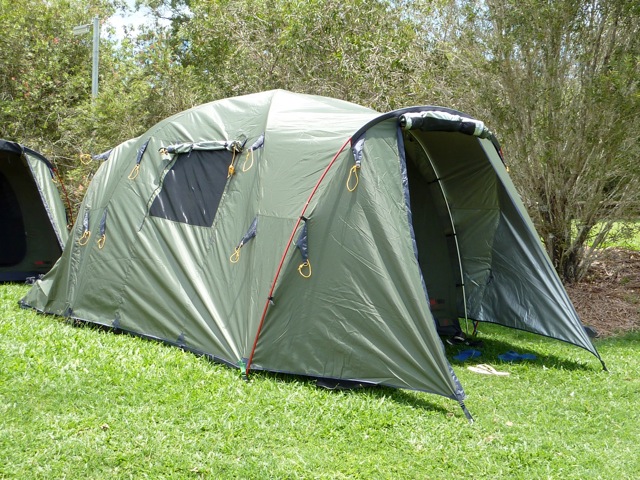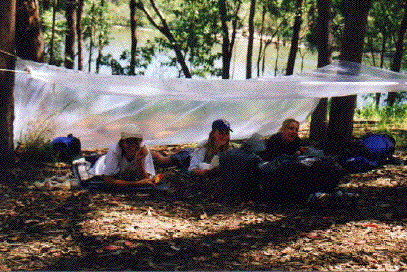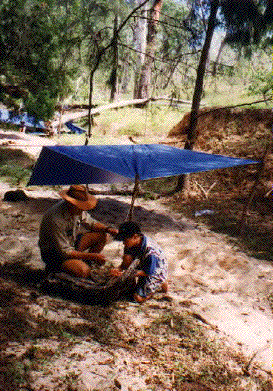- We want your experience on camp to be different and enjoyable. To insure this happens you need to observe the following basic rules:
- Language used should be pleasant and in conversational tone - eg. it is not necessary to shout and swear.
- Mobile phones and iPods must be left at home.
- There is no need to have money, there is nowhere to spend it.
- Jewellery and other valuables should not be brought on camp.
- Chips, soft drink, chewing gum and lollies are not to be brought on camp.
- The only people who should be in a tent/room are those that sleep there.
Emergencies
- In case of any emergency (fire, accident, boating accident, snake sighting) immediately contact nearest teacher or parent - return to the centre if necessary.
- In case of fire in the kitchen, main building or in a tent/room, inform the nearest adult and then move to the Emergency Evacuation Point by the shortest route and in an orderly manner.
Hygiene
- Wash hands with soap before you eat or prepare food and after you go to the toilet.
- It is best to let cups and plates drain dry.
- If you feel ill at any time, tell your teacher immediately.
Cooking and kitchen
(Black Gully Campus only)
- When working in a cooking group, you complete only the tasks allocated to you - eg. collecting the ingredients, chopping up vegetables or cooking.
- Use gloves to handle pots.
- When using cutting knives, use a board and always cut away from your body.
- DO NOT waste water by allowing the tap to run - if you require water use a container to obtain the required amount.
- Adults only are to use the 'Zip Heater' and Microwave in the kitchen.
Bush camping
- Cooking over an open fire is sometimes dangerous.
- Keep well back from the fire unless it is your task to do the cooking.
- No running or playing near the fire.
- When working in a cooking group, you complete only the tasks allocated to you eg. collecting wood, fire lighting, food preparation, cooking.
- Do not use the axe or light fires without permission.
- Use a pot hook or gloves to handle camp-ovens, billies or pots.
Waste management
- There are specific bins for a variety of recyclable materials. All campers (pupils and adults) and especially those handling food and drink containers need to be aware of the recycling and waste management procedures.
Self-directed activities
- During this time you must stay within the area specified by the teachers.
- Do not swim or use canoes without permission.
- Keep off the low ropes course unless supervised by an adult.
- Do not run on the concrete and around the buildings/tents.
Shoes
- You must always have shoes on.
- "Dry shoes" for around camp, in the kitchen and on expeditions.
- "Wet shoes" for canoeing, swimming and other water activities.
- Thongs are ONLY for going to the toilet/shower at night.
Boundaries
- On your arrival the boundaries of the Centre will be outlined. Our expectation is that students will remain inside those boundaries unless accompanied by an adult.
Group challenges
- The Group Challenge adventure course is to be used only under adult supervision.
Swimming
- Swimming only happens under adult supervision in the defined area after you have been marked on the swimming roll.
Canoeing
- Canoeing only occurs under the supervision of trained TEEC staff.
- There should be a LEAST 2 people in each canoe.
- Participants must be wearing a PFD.
- PFDs must always be returned to the drying line after use.
- Canoes must be lifted NOT dragged from the water.
When you come to Tinaroo Environmental Centre you will be staying under canvas. At the Centre you will have to put up a Tent. If you are camping away from the Centre you will need to erect what we call a bivvy.
A Tent at TEEC

A Bivvy at TEEC

Building Bivvies
Equipment
- Plastic bivvy sheet
- Bivvy cords (at least 8 per bivvy)
- Long Rope (optional)
- Pegs (optional)
- Ground sheet
Knots
You will need to know how to tie some knots to erect the bivvy effectively. Use the following links to learn to tie them.
- Bowline
- Reef Knot
- Clove Hitch
- Rolling Hitch
Vegie Ball
A 'vegie ball' enables the string (or bivvy cord) to be attached to the plastic sheet.
Construction
- Grab a handful of vegetable matter e.g. leaves or grass
- Place into the corner of plastic and twist into a ball.
- Attach bivvy cord to 'vegie ball' by using a clove hitch.
- This can then be attached to trees, logs, rocks or pegs by a rolling hitch.
- Combine bivvy cords with reef knots to make a longer cord.
 Considerations
Considerations
- In windy or rainy conditions, low shelters are advisable.
- Position shelter considering sun and wind direction.
- Look for hazards such as ant's nests, stinging trees, low branches and dead trees etc.
- Flat ground is more comfortable than a slope.
As you can see the design of a bivvy depends on the conditions encountered at the particular site of its construction. There is no set solution as long as the bivvy serves its purpose. There are many designs with various advantages and disadvantages.